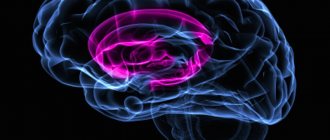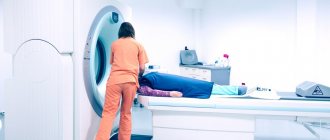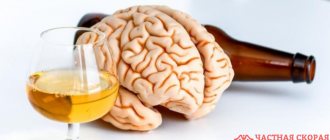Parkinsonism is a complex syndrome that manifests itself with characteristic symptoms: gait disturbance, increased muscle tone, slowness of movement and difficulty maintaining balance. This syndrome is classified according to the cause of its occurrence, and one of its varieties is vascular parkinsonism. The main etiological factor is cerebral vascular disease, which leads to organic damage to the central nervous system (brain). The disease tends to progress, and pathological changes are often irreversible. After diagnosis and confirmation of the vascular component, the patient is prescribed maintenance therapy aimed at stabilizing the condition and preventing complications.
Definition
Parkinsonism is a group of disorders of the nervous system that manifest themselves with a number of characteristic symptoms. However, due to their occurrence, these diseases are usually divided into several groups. These include:
- idiopathic parkinsonism (Parkinson's disease) - occurs without a specific reason;
- secondary (including vascular, toxic, traumatic and others) - develops against the background of pathologies of other organ systems;
- parkinsonism, which occurs against the background of pathologies of the central nervous system.
Vascular parkinsonism belongs to the second group. It is a consequence of organic damage to blood vessels that participate in the blood supply to the brain. The theory of this disease has been confirmed with the development of neuroimaging techniques. The disease is quite rare, the frequency of its occurrence is no more than 2-15% of all cases of parkinsonism. Most often, the pathology develops after an ischemic stroke or as a result of discircular encephalopathy. Patients include people of any gender and age, most often over 40 years old.
Symptoms of Parkinsonism
Parkinsonism is the second most common neurodegenerative disease after Alzheimer's disease. It is mainly characteristic of older people, but there is also a juvenile form of parkinsonism, which occurs before the age of 20. The disease affects men more often than women.
The main manifestations of parkinsonism are:
- tremor in the arms or legs, trembling of the head, lower jaw, etc.
- inconsistency in the movement of arms and legs while walking
- impaired ability to maintain balance
- rigidity of the muscles of the spine, limbs, neck, difficulty, stiffness and slowness of voluntary movements
- gait with small, quickening steps
- fixing the body in the so-called supplicant pose (the body is tilted forward, the head is lowered to the chest, the arms and hands are in a bent position)
- poor facial expressions, rare blinking
- difficulty performing complex manipulations
In addition to motor disorders, autonomic disorders (for example, greasiness of the face, increased sweating, drooling) and mental changes (emotional dullness, aspontaneity) are noted.
As parkinsonism develops, muscle tone increases so much that the patient loses the ability to care for himself and spends most of his time in a lying or sitting position.
Causes and mechanism of development
Vascular parkinsonism syndrome is a consequence of disruption of the extrapyramidal system. It is a collection of ganglia (nerve ganglia), substantia nigra and other structures of the midbrain that regulate motor activity and coordination of movements. When the blood supply to certain parts is disrupted, a characteristic set of symptoms occurs, which manifests itself as movement disorders. Cerebral vessels of different diameters are responsible for blood circulation in the brain tissue. The cause of vascular parkinsonism is their pathology, as a result of which parts of the central nervous system experience a deficiency of oxygen and nutrients.
The disease can also manifest itself when small-caliber vessels are damaged.
The causes of this disorder can be the following diseases:
- hypertensive encephalopathy - disruption of the functioning of parts of the brain caused by a constant increase in blood pressure;
- sclerosis of small arterioles - proliferation of dense connective tissue instead of an elastic membrane;
- vascular amyloidosis is a pathology of protein metabolism that occurs with the deposition of a specific protein (amyloid) in tissues;
- systemic lupus erythematosus is a chronic autoimmune disease;
- antiphospholipid syndrome is an autoimmune pathology associated with the formation of antibodies to phospholipids, which are one of the main structural components of cell membranes.
Involvement of large cerebral arteries is rare. In such patients, strokes of the basal ganglia are diagnosed, which is manifested by severe symptoms. Diseases that can lead to the following consequences:
- thrombosis of the middle cerebral artery or its branches;
- atherosclerosis of cerebral vessels - the appearance of dense sclerotic plaques;
- arteriovenous malformations - a pathology in which there is no capillary network, and blood from the arteries enters directly into the veins;
- nodular vasculitis - inflammation of the walls of blood vessels, which can also occur with a necrotic component.
REFERENCE! Vascular parkinsonism is recorded in 11% of patients who have suffered a cerebral stroke. It is also diagnosed in 14% of cases of discircular encephalopathy.
The main pathogenetic link in the development of parkinsonism is an increase in blood pressure, in some cases - organic damage to the vascular walls, a decrease in their strength and elasticity. In such patients, the porosity of the walls increases, as a result of which fluid easily penetrates beyond the arteries and accumulates in the surrounding tissues. This causes swelling of the brain, disruption of nutrition and blood supply to nerve cells, and then their necrosis (death). Regenerative processes proceed slowly, so the development of spongiosis is observed - sponginess of the white matter.
The main reason for brain dysfunction is a lack of blood supply to certain parts of the brain.
Motor activity is controlled by mediators - biologically active substances. The most important of them are dopamines: they activate muscle movements, have an exciting effect and eliminate stiffness. When the blood supply to the cells of the extrapyramidal system is disrupted, the death of dopamine receptors is observed. The balance is disturbed, and motor activity is regulated by dopamine antagonists - acetylcholine and gamma-aminobutyric acid. These substances produce the opposite effect, so under their influence typical signs of parkinsonism appear.
Causes of parkinsonism
With parkinsonism, changes occur in the structures of the brain: in particular, degeneration of cells in the substantia nigra of the brain. It is this structure that is responsible for muscle tone, regulates motor function, with its participation the processes of breathing and cardiac activity occur, and vascular tone is maintained.
Many factors can provoke these changes: infectious diseases, atherosclerosis, poisoning with various substances, including carbon monoxide, lead, mercury. The hereditary factor also plays a certain role, but in this case parkinsonism begins earlier, including in adolescence.
Classification
Vascular parkinsonism may differ in its clinical manifestations. Depending on its cause, neurological symptoms or signs of circulatory disorders may predominate. The first classification identifies three types of syndrome, based on the nature of its course:
- acute - the clinical picture appears suddenly, but does not progress further, and the patient’s condition may even improve;
- stepwise progressive - periods of exacerbation alternate with periodic phases of remission, during which a decrease in the severity of symptoms is observed;
- steadily progressing (the most rare) - during the course of the disease there are no periods of improvement, the patient’s condition is constantly deteriorating.
The second classification is based on the etiology of parkinsonism syndrome. She identifies two main types of pathology, which differ, among other things, in their clinical manifestations.
- Post-stroke form - develops during the first 6-12 months after a stroke and is associated with impaired circulation in large vessels. The course is most often acute; during diagnosis, single areas of ischemia are detected. Manifestations may be one-sided.
- The non-stroke form occurs when small cerebral vessels are damaged. Imaging reveals diffuse damage to brain structures, which is the cause of bilateral development of symptoms. The disease often progresses in steps.
REFERENCE! The last variant of the development of vascular parkinsonism (steadily progressing) is the most dangerous. This type is more typical for organic pathologies of the central nervous system, therefore, in diseases of vascular origin, its diagnosis is difficult.
Parkinsonism and its main nosological forms
Parkinson's disease (PD) is a chronic, steadily progressive disease of the central nervous system with degeneration of nigrostriatal neurons and dysfunction of the basal ganglia. It is one of the most common neurodegenerative diseases, which ranks third among the causes of death after cardiovascular diseases and cancer.
Parkinsonism has been known for a long time; the first reports of the treatment of similar disorders were made 1000-2500 BC.
The first clinical description belongs to the English physician James Parkinson, who published “An Essay on the Shaking Palsy” in 1817.
A detailed clinical analysis of the pathology complex was made in 1879 by the famous French neurologist Jean Martin Charcot.
Currently, the classification of parkinsonism includes: I. Parkinson's disease (it accounts for about 70-80% of all registered cases). II. Secondary (symptomatic) parkinsonism (about 15%) includes the following options: drug, toxic, post-hypoxic, encephalitic, traumatic, with volumetric processes, with hydrocephalus, vascular. III. Parkinsonism in various degenerative diseases with damage to the extrapyramidal system (“Parkinsonism-plus”, about 10%): multisystem atrophies (striatonigral degeneration, olivopontocerebellar degeneration), progressive supranuclear palsy (Steele-Richardson-Olszewski disease), corticobasal degeneration, dementia with Lewy bodies , parkinsonism-ALS-dementia, Wilson-Konovalov's disease, Huntington's disease (juvenile variant of Westphal), Fahr's disease (idiopathic calcification of the basal ganglia), Alzheimer's disease, others.
The main nosological form of parkinsonism is Parkinson's disease.
The worldwide prevalence of PD is approximately 1%.
The etiology of PD is unknown. Its pathogenesis is based on the degeneration of so-called dopaminergic neurons. PD is predominantly sporadic, but if close relatives have PD, the risk of developing it increases.
Clinical manifestations of PD occur when the amount of dopamine in the caudate nucleus and putamen decreases by at least 70%. Symptoms of PD develop gradually, initially affecting the limbs on one side. The clinical picture of PD is characterized by a combination of hypokinesia, rigidity, resting tremor, and postural disturbances.
Hypokinesia is manifested by a decrease in motor activity, slowness of movements, and a decrease in the amplitude of actions.
Rest tremor classically begins in the distal upper or lower extremity and resembles hand movements “counting coins or rolling pills.” Subsequently, the tremor involves the homolateral limb, lower jaw, and opposite limbs. Sometimes there is postural tremors of the hands.
Rigidity in PD is manifested by a plastic increase in muscle tone, often with a “cogwheel” phenomenon that increases during the study. Postural instability, which occurs in advanced stages of PD, is characterized by instability when turning, staggering when walking, and falls. In the future, patients are forced to use support devices.
In addition to motor disorders, non-motor manifestations develop in PD: neuropsychiatric disorders; sleep disorders; autonomic disorders; sensory disorders.
Depending on the predominance of a particular symptom in the clinical picture of PD, it is customary to distinguish the following clinical forms of the disease: trembling, akinetic, as well as mixed forms - akinetic-rigid and rigid-tremulous.
There are five degrees of severity of PD (stages of the disease according to Hoehn and Yahr): stage 1 - unilateral symptoms of parkinsonism; Stage 2 - bilateral symptoms of parkinsonism without postural disturbances; Stage 3 - moderate postural instability occurs; Stage 4 - significant limitation of motor activity, falls, but the ability to move independently is still retained; Stage 5 - the patient is bedridden or wheelchair-bound.
In the later stages of PD, the clinical picture changes; additional motor (motor fluctuations, drug-induced dyskinesias, walking disorders, falls, freezing and akinetic crises) and non-motor (vegetative, cognitive, neuropsychiatric) syndromes appear.
Patients may experience long periods of decompensation - from several days to several weeks, as well as akinetic crises - severe episodes of akinesia, accompanied by dysphagia, autonomic disorders, hyperthermia, oliguria, and confusion. The reasons for this may be: violation of the regimen for taking antiparkinsonian drugs, their complete o); taking drugs that block DA receptors (primarily antipsychotics); exacerbation of concomitant somatic diseases, stress; operations, injuries, dehydration of the body.
PD can be diagnosed with certainty only through autopsy. Clinical diagnosis of parkinsonism syndrome requires the presence of hypokinesia and at least one of the three main symptoms of parkinsonism: resting tremor, rigidity and postural instability.
An MRI of the brain is mandatory if the patient has parkinsonism syndrome. This study is primarily necessary to differentiate idiopathic Parkinson's disease and secondary parkinsonism, as well as “parkinsonism-plus”.
The main directions of treatment for PD are: 1. Pharmacotherapy. 2. Medical and social rehabilitation. 3. Therapeutic physical education (PT). 4. Neurosurgical treatment.
Pharmacotherapy for PD is aimed at normalizing the biochemical imbalance and requires constant use of medications, since when treatment is stopped, the symptoms of PD return to their original level.
At an early stage, treatment of PD consists of prescribing monotherapy followed by a transition to combination treatment.
In the early stages of the disease, it is generally accepted to prescribe DA receptor agonists and MAO-B inhibitors in the form of monotherapy or combination to patients under the age of 70 years.
In patients over 70 years of age, when the patient's life expectancy is shorter, and there are cognitive impairments, therapy can be started immediately with DOPA-containing drugs in the minimum effective dose, which is adjusted gradually.
Anticholinergics (Cyclodol, Akineton) are prescribed mainly at the early stage of PD - as monotherapy or in combination with other antiparkinsonian drugs; they predominantly affect resting tremor.
Currently, they are prescribed only to young patients with severe rest tremor and intact cognitive functions. The high incidence of side effects and low effectiveness compared to other groups significantly limit their use. Amantadine preparations (Midantan, PC-Merz).
Amantadines can be prescribed both at the initial stage as monotherapy and in combination with other antiparkinsonian drugs in the later stages of PD. The drugs are also effective in reducing the severity of dyskinesia caused by taking levodopa. The infusion form of amantadine sulfate (PC-Merz) is used in the treatment of decompensations and akinetic crises in PD.
Dopamine receptor agonists have the ability to directly stimulate DA receptors in the brain. Non-ergoline DA receptor agonists (Pronoran, Mirapex, Requip Modutab, Newpro) are widely used at all stages of PD. In addition to controlling movement disorders, they showed an antidepressant effect, which is very important, since the frequency of depressive syndrome in PD is quite high.
ADAR monotherapy in the early stages of the disease makes it possible to delay the prescription of levodopa drugs, as well as the development of motor fluctuations and drug-induced dyskinesias.
MAO type B inhibitors (Rasagiline). The administration of drugs in this group leads to an increase in the amount of dopamine in neurons. They are also believed to have a neuroprotective effect. They can be prescribed in the early stages as monotherapy, as well as in combination with levodopa.
COMT inhibitors. COMT inhibitors increase the bioavailability of levodopa by reducing the level of its inactive metabolites.
Peripherally acting COMT inhibitors do not cross the BBB and interfere with methylation of levodopa in the gastrointestinal tract and bloodstream. Thanks to this, they maintain the concentration of levodopa at a certain level. These drugs include entacapone.
The combination of entacapone with levodopa drugs can reduce the daily dose of DOPA-containing drug by 15–30%.
It is prescribed only in combination with levodopa drugs (Stalevo), since when prescribed as monotherapy it does not have an independent antiparkinsonian effect.
Levodopa preparations (Madopar, Nacom, Tremonorm, Tidomet-forte, Duellin, Sindopa). Dopamine does not cross the BBB, so a metabolic precursor of dopamine, levodopa, has been proposed as a drug, which crosses the BBB and is metabolized into dopamine in the brain. Today, levodopa drugs are the most effective drugs, the “gold standard”, used for the treatment of PD. However, they do not stop the progression of PD. Moreover, after an average of 5 years of using DOPA-containing drugs in patients with PD, their effect decreases, motor fluctuations and drug-induced dyskinesias appear.
The timing of treatment with levodopa depends on the severity and rate of progression of the disease, the professional activity of the patient, and family and household status. In general, it is necessary to prescribe drugs from this group when there are severe motor disorders that cannot be relieved by other antiparkinsonian drugs.
Neurosurgical treatment.
A decrease in the effectiveness of pharmacotherapy, the appearance of motor fluctuations and drug-induced dyskinesias are indications for the use of neurosurgical treatment, which over the past two decades has firmly taken its place in the algorithm for the management of patients with PD. Currently, three types of neurosurgical interventions are used for PD: stereotactic destructive methods (ventrolateral thalamotomy, pallidotomy, subthalamotomy and their combination), stimulation methods (implantation of electrodes into subcortical structures followed by chronic electrical stimulation) and intracerebral transplantation of dopaminergic neurons of the mesencephalon of the human embryo, effectiveness which continues to be studied.
The most modern method of surgical treatment of PD is deep electrical stimulation of the brain. The DBS procedure consists of implanting electrodes with 4 contacts into target areas within the subcortical formations of the brain; The electrodes are connected to a stimulator implanted under the skin, which delivers high-frequency electrical impulses to the stimulated nucleus.
Medical and social rehabilitation.
The high degree of disability with steadily progressing PD, the socio-economic losses suffered by society necessitate the creation of a system of medical and social rehabilitation, which should include dispensary observation of patients; creating schools for patients and their relatives, conducting training programs and psychotherapeutic classes, creating public organizations and support groups. Exercise therapy is of great importance, which can be selected individually depending on the severity of the disease in a particular patient, exercise therapy classes in groups, dance therapy, as well as occupational therapy and physiotherapy.
Literature: 1. Shtok V.N., Diagnosis and treatment of extrapyramidal disorders. - M., 2000. - P. 138. 2. Shtok V. N., Fedorova N. V. Treatment of parkinsonism. - M., 1997. - 194 p. 3. Yakhno N. N. Modern approaches to drug treatment of Parkinson’s disease // Clinical pharmacology and therapy. - 1994. - No. 3-4. - P. 92 - 97. 4. Levin O.S., Fedorova N.V., Parkinson’s disease. - M., - 2012. 5. N.V. Fedorova, I.P. Chigir, Parkinson's disease - Attending physician - 2005. -№8.- p.26-28.
Symptoms of the disease
In most cases, the symptoms of vascular parkinsonism develop symmetrically. Since the syndrome manifests itself against the background of acute circulatory disorders, the clinical picture includes signs of both vascular insufficiency and encephalopathy. There are several symptom complexes that directly indicate the development of parkinsonism:
- gait disturbance - it becomes slow, the patient’s legs do not rise high from the floor, there are signs of muscle weakening;
- deterioration in coordination of movements - when trying to maintain the center of gravity, the patient’s body leans forward and the legs bend at the knees; in advanced cases, cases of falling while walking may occur;
- decreased activity of small muscles, which leads to a lack of facial expressions, changes in handwriting, and difficulties in performing work related to fine motor skills;
- headaches, dizziness, the appearance of various noises in the head - these signs are individual and do not appear in all cases;
- regression of intellectual development, deterioration of memory and attention.
The clinical picture of secondary parkinsonism should be distinguished from the manifestations of Parkinson's disease. The second case is characterized by muscle tremors - trembling of the muscles of the limbs, most often the hands. With vascular parkinsonism, similar signs are observed in no more than 4% of patients, but other symptoms are present. Thus, this disease is more characterized by damage to the lower extremities and a chronic step-like course. Another distinguishing feature will be the body's response to treatment with levodopa - in Parkinson's disease, this drug causes improvement.
Parkinson's disease (parkinsonism)
Definition.
Parkinson's disease (PD) is a chronic brain disease. The main manifestations (symptoms) of the disease are associated with a decrease in the number of nerve cells that produce the substance dopamine. Dopamine is involved in the transmission of nerve impulses to ensure normal motor activity. The lack of dopamine in the parts of the brain involved in the regulation of movements is the main cause of slowness and limitation in the execution of habitual movements.
Parkinson's disease refers to primary or idiopathic parkinsonism, which accounts for 80-90% of the total number of patients with parkinsonism syndrome. Secondary parkinsonism is much less common and accounts for 10-15%, for example: vascular, drug-induced, toxic, post-encephalitic, post-traumatic, parkinsonism due to tumors and hydrocephalus, against the background of metabolic encephalopathy. Parkinsonism within the framework of neurodegenerative diseases is 8-12% (atypical parkinsonism, “parkinsonism-plus” - progressive supranuclear palsy, multiple system atrophy, diffuse Lewy body disease, corticobasal degeneration).
Historical reference.
Parkinson's disease was described about 200 years ago (1817) by the English physician James Parkinson in his famous “Essay on the Shaking Palsy,” in which he summarized the results of observations of six patients. Since then, PD has been studied in detail, all its symptoms have been specified, but the portrait of the disease compiled by J. Parkinson remains accurate and capacious.
Epidemiology.
PD ranks fourth in prevalence after dementia, epilepsy, and cerebrovascular pathology in patients of the older age group. Thus, about 1-2% of people over 65 years of age suffer from PD. Depending on the age at which the first signs of PD are detected, the following forms are distinguished: juvenile form - onset before 20 years of age; early onset – before 40 years of age; typical onset is over 60 years of age.
Etiology.
The possibility of a genetic predisposition has been discussed for many years, but the genetic factor does not always play a major role, because familial forms of parkinsonism account for only about 5-10%, while sporadic parkinsonism occurs in 80-90% of cases. Genetic factors play the greatest importance at the early onset of the disease, and in a later age group other factors, such as involutional changes in the brain and environmental or toxic factors, become more important.
Pathogenesis.
The pathogenetic basis of PD is a sharp decrease in the amount of dopamine in the substantia nigra and striatum. Dopamine synthesis occurs in the bodies of dopaminergic neurons located in the compact zone of the substantia nigra. Here it is formed in the form of small vesicles - granules, which are transported along the axons of nigrostial neurons to the axon endings in the caudate nucleus and accumulate in front of the presynaptic membrane. Under the influence of incoming nerve impulses, transmitter quanta are released into the synaptic cleft, which affects the dopaminergic receptors of the postsynaptic membrane and causes its depolarization. It is estimated that about 80% of dopamine is reabsorbed back into the presynaptic space or inactivated by the enzyme COMT (catechol O-methyltransferase) or MAO-B (monoamine oxidase type B). The most likely mechanisms of neuronal damage in PD are: oxidative stress; increased content of iron ions; specific enzymatic defects of complex I of the respiratory chain were identified in the mitochondria of the substantia nigra; induction of apoptosis processes due to the excitotoxic effect of glutamate and aspartate. But the real triggering factor for these processes has not been fully determined. In addition to dopaminergic neurons of the substantia nigra, other groups of neurons undergo degeneration in Parkinson's disease, including neurons of the dorsal nucleus of the vagus nerve, neurons of the olfactory bulb, noradrenergic neurons of the locus coeruleus, serotonergic neurons of the raphe nuclei, cholinergic neurons of Meynert's nucleus, as well as neurons of the cerebral cortex and some autonomic plexuses. Because of this, in addition to dopamine deficiency, dysfunction of the serotonergic, noradrenergic and cholinergic systems occurs. Disease manifestations such as anosmia, autonomic failure, depression, and dementia are associated with damage to extra-nigral structures.
Clinical manifestations.
Parkinson's disease begins gradually and progresses slowly. It takes 10-15 years from the moment of the first nonspecific (premotor manifestations such as: constipation, sleep disturbances, loss of smell, depression, behavior disorder in the REM phase) to the main motor symptoms. The first motor symptoms of PD appear when more than 50% of the neurons of the substantia nigra die, and the decrease in dopamine levels is up to 80%.
| Premotor symptoms | Connection with brain structures | Braak stage |
| Constipation (constipation) | Dorsal vagal nucleus; neurons of the abdominal plexus. | 1 |
| Sleep disturbance or loss of smell | Olfactory bulb; anterior olfactory nucleus | 1 |
| Depression | Bluish area, suture nuclei. | 2 |
| Rapid eye movement disorder (REM) sleep behavior disorder | Dorsal midbrain and pons; bluish place. | 2 |
| Akinesia | Black substance. | 3 |
The main ones in the clinical picture are motor symptoms:
- Decreased motor activity (hypokinesia). The main manifestations of hypokinesia are difficulties in performing “small” movements (fastening buttons, tying shoelaces, cutting food, brushing teeth); shuffling gait, difficulty turning in bed, getting out of a chair; change in speech (decreased modulation and emotional coloring of the voice, which becomes inexpressive, monotonous, fading); change in handwriting - micrography (handwriting becomes small, letters are connected, their size decreases towards the end of the sentence); amimia – mask-like face, poor facial expressions; “Presiding pose” - the neck, torso and limbs at the joints are slightly bent, pressed to the body; propulsion, retropulsion, lateropulsion - irresistible acceleration of the patient’s movement forward, backward, to the side when walking or after a slight push, the inability to stop the movement started or change direction; acheirokinesis – absence of friendly arm movements when walking; paradoxical kinesia - in patients who can barely move with assistance and are bedridden - the possibility of rapid movements (running, jumping, waltzing, etc.) under the influence of emotional factors.
- Increased muscle tone (rigidity) – felt as “stiffness”, muscle tension (the “wax doll” phenomenon, the “cogwheel” phenomenon - occurs when a tremor is superimposed on rigidity)
- 3. Rest tremor (in 80% of patients) of the “rolling pills”, “counting coins” type - rhythmic trembling of the distal parts of the hands, especially the fingers, of low amplitude and frequency, stopping during purposeful movements and disappearing during sleep.
- Balance imbalance (postural instability)
PD is clinically manifested not only by motor disorders, but also has a whole range of non-motor manifestations that occur in all patients, regardless of the age of onset of the disease and the stage of the disease:
- Cognitive impairment
- Affective disorders (depression, anxiety, apathy, obsessive-compulsive syndrome)
- Behavioral disorders (addiction to gambling, compulsive shopping, hypersexuality, bulimia)
- Mental disorders (hallucinations, delusions, delirium)
- Sleep disorders (insomnia, hypersomnia, parasomnia)
Autonomic disorders in PD:
- Orthostatic hypotension
- Greasy scalp, increased formation of earwax.
- Sialorrhea
- Sweating
- Distal hyperhidrosis
- Urinary dysfunction
- Constipation
- Vagoinsular crises
Classification.
Parkinson's disease is classified according to the form, stage and rate of progression of the disease. Forms of the disease. Depending on the predominance of a particular symptom in the clinical picture, the following forms are distinguished: mixed (akinetic-rigid-tremor), akinetic-rigid and trembling. The mixed form is detected in 60-70% of cases of Parkinson's disease, akinetic-rigid - in 15-20% of cases of Parkinson's disease, trembling - in 5-10% of cases of Parkinson's disease. As the disease progresses, its shape may change.
Stages of the disease. The classification of the stages of Parkinson's disease proposed by Hoehn and Yarh (1967) is generally accepted: stage 1 - Hemiparkinsonism (unilateral manifestations) Stage 1.5 - unilateral manifestations involving the axial muscles. Stage 2 – Bilateral disorders without imbalance. Stage 2.5 – Bilateral disorders with initial manifestations of postural instability, but with independent restoration of balance during the push test. Stage 3 – Bilateral disorders with the addition of postural disorders. Stage 4 – Severe impairment, but can stand and walk without assistance. Stage 5 – complete disability. The patient is bedridden or wheelchair-bound.
Rate of progression.
There are three options for the rate of progression of Parkinson's disease (subject to adequate treatment):
- rapid rate of progression, in which a change in stages of the disease (first - second or second - third) occurs within 2 or less years;
- moderate rate of progression, in which the change of stages occurs in more than 2 years, but not more than 5 years;
- slow rate of progression with changes in stages after more than 5 years.
Diagnostics.
Currently, for the clinical diagnosis of Parkinson's disease, the brain bank criteria of the UK Parkinson's Disease Society are most often used (A. Hughes et al., 1992). Hypokinesia in combination with at least one of the following symptoms:
- muscle rigidity;
- resting tremor with a frequency of 4-6 Hz;
- postural instability.
Exclusion criteria for Parkinson's disease:
- history of repeated strokes with stepwise progression of parkinsonian symptoms;
- history of repeated traumatic brain injury;
- encephalitis in anemnesis;
- oculogyric crises;
- treatment with antipsychotics at the time of symptoms;
- family nature of the disease (more than 1 relative with a similar disease);
- the presence of long-term remission;
- strictly unilateral symptoms for more than 3 years;
- downward gaze paralysis;
- early rapidly progressing autonomic failure;
- cerebellar signs;
- early-onset dementia with memory, speech, and praxis impairments;
- Babinski's symptom;
- presence of cerebellar atrophy or communicating hydrocephalus on computed tomography;
- lack of response to high doses of levodopa (with the exception of malabsorption);
- contact with toxic substances that cause parkinsonism.
Criteria confirming the diagnosis of Parkinson's disease (at least 3):
- unilateral onset;
- rest tremor;
- progressive course;
- persistence of symptom asymmetry with predominance on the initially involved side;
- high effectiveness of levodopa drugs (reduction of symptoms by 70–100%);
- severe choreiform dyskinesias induced by levodopa;
- persistence of response to levodopa for 5 years or more;
- the duration of the disease is 10 years or more.
Differential diagnosis of Parkinson's disease is carried out with the following diseases: essential tremor, juvenile (juvenile) parkinsonism, drug-induced parkinsonism, vascular parkinsonism, progressive supranuclear palsy (Steele-Richardson-Olszewski syndrome), multiple system atrophy, diffuse Lewy disease, hepatolenticular degeneration.
Additional research methods.
- Structural neuroimaging - CT, MRI - are not very informative for diagnosing PD and are used to exclude secondary parkinsonism.
- Functional neuroimaging (fluorodopa PET, SPECT) the potential of these methods is high, because make it possible to detect changes in dopamine metabolism 4-6 years before the onset of clinical symptoms, but at the moment this is a technically complex and expensive research method, which does not allow its use in routine practice to identify PD.
- Transcranial sonography reveals increased hyperechogenicity of the substantia nigra, due to the increased content of ferric iron, which is detected in 80-90% of patients with PD.
- Olfactory tests (Pennsylvania test) Olfactory dysfunction is the earliest premotor symptom of PD. This test is most often used if tremor is predominant in the clinic, making a differential diagnosis between essential tremor and PD, because only idiopathic parkinsonism will be characterized by changes in olfactory tests.
Principles of treatment.
There are three main areas in the treatment of Parkinson's disease:
- Neuroprotective therapy that aims to slow or stop the degeneration of neurons in the brain. In recent years, several dozen agents have undergone experimental and clinical trials that are potentially capable of influencing various stages of the neurodegenerative cascade of cell death (antioxidants, glutamate antagonists, calcium channel blockers, anti-inflammatory drugs, trophic factors, etc.), but so far their effectiveness has not been proven managed.
- symptomatic therapy, which allows to reduce the main symptoms of the disease by correcting the neurochemical and neurophysiological imbalance that occurs in the brain;
- physical and socio-psychological rehabilitation.
Drug treatment.
Currently, treatment is carried out focusing mainly on the symptomatic effect of the drugs. Currently, antiparkinsonian drugs used for Parkinson's disease include 6 groups of drugs:
- drugs containing levodopa (a precursor of dopamine) - increase the synthesis of dopamine in the brain;
- dopamine receptor agonists – stimulation of dopamine-sensitive receptors;
- tricyclic antidepressants – inhibition of the process of reabsorption (capture) of dopamine by presynaptic structures;
- amantadine preparations – stimulation of the process of release (release) of dopamine from the presynaptic terminal;
- monoamine oxidase type B inhibitors;
- catechol-O-methyltransferase inhibitors – inhibition of dopamine catabolism (breakdown);
Since the mechanism of action of drugs in these groups is different, if necessary, they can be combined as part of combination therapy.
Drug therapy for patients with Parkinson's disease is selected individually for each clinical case and depends on a number of factors, including the severity of functional impairment, the form of the disease, the patient's age, individual sensitivity to drugs, and pharmacoeconomic considerations.
The goal of therapy is to restore impaired motor functions using minimal effective doses of drugs. During the first months of the disease, when manifestations of the disease are minimal and do not interfere with daily social or household activities, drug therapy may not be prescribed. At the beginning of treatment, monotherapy is usually used, and if its effectiveness decreases as the disease progresses, combination therapy is used.
Non-drug treatment methods.
Treatment of chronic diseases, along with the prescription of medications, requires the implementation of measures for socio-psychological support of patients. Educational programs should provide patients with selective information about the disease necessary to develop a sense of control over the disease. The treatment package should include neuropsychological training, speech therapy, and therapeutic exercises. Regular physical exercise, including aerobic exercise, isometric exercise, stretching and coordination, can improve the mobility of patients without reducing parkinsonian symptoms. Good nutrition is important to prevent weight loss and muscle loss. To implement the entire range of measures for the medical and social rehabilitation of patients, it is advisable to create a special service. It is necessary to prepare specially trained paramedics who would coordinate the work of social services, teach relatives how to care, and educate patients.
Neurosurgical treatment.
If conservative therapy is ineffective, especially when severe dyskinesias do not allow prescribing doses of levodopa necessary to correct the symptoms of Parkinson's disease, the question of surgical treatment is raised (pallidotomy, thalamotomy, implantation of intracerebral stimulators into the globus pallidus, thalamus, subthalamic nucleus, intracerebral transplantation of embryonic adrenal tissue or substantia nigra).
Diagnostic methods
It is difficult to make a diagnosis based solely on the presence of clinical signs, since the manifestations of vascular parkinsonism may vary. More detailed diagnostics are necessary to confirm the data of the initial examination, as well as to determine the cause of the pathological process. It may include the following techniques:
- examination by a neurologist - at this stage it is possible to establish muscle rigidity, especially in the lower extremities, various neurological disorders, as well as a decrease in intellectual development;
- ultrasound diagnostics of the vessels of the neck and head - carried out to assess the speed of blood flow, as well as to exclude thrombosis, narrowing of the vascular walls and other organic changes;
- Magnetic resonance imaging of the brain is the most informative way to diagnose the nervous system; the images will clearly show areas damaged by a stroke.
For more detailed diagnostics, additional techniques can be used. These include PET (positron emission tomography) and other methods that allow us to obtain the most detailed picture of the disease. However, due to the high cost and complexity of the procedure, they are rarely used. To make a diagnosis, a simple examination, ultrasound of blood vessels and MRI of the brain are sufficient.
It is impossible to make a final diagnosis based on the data of the initial examination - a comprehensive examination will be required
Treatment tactics
Treatment of vascular parkinsonism is complex and includes the use of several groups of drugs. They must be taken in a course, since it will not be possible to completely restore the functions of the nervous system. Their action is aimed at stabilizing the patient’s condition, reducing the frequency of relapses, improving coordination of movements and maintaining the level of intellectual development.
The first stage is basic therapy. It involves taking medications to improve cerebral circulation. If necessary, anticoagulants are prescribed - drugs that thin the blood and prevent the formation of blood clots.
The second stage is symptomatic treatment. Drugs prescribed against vascular parkinsonism are selected individually:
- antiparkinsonian drugs - cause positive dynamics in 30-50% of patients;
- nootropics - substances to activate brain activity;
- antidepressants;
- painkillers.
The last stage is physical therapy. The workouts are done at home and include simple exercises to improve muscle strength and elasticity. It is also useful to perform tasks to develop motor coordination.
Treatment
The early onset of the disease also affects treatment tactics - it must be planned decades in advance. Typically, therapy begins with the administration of dopamine receptor agonists. First, these drugs are better tolerated by young people compared to older patients in classical cases. And secondly, when standard treatment with Levodopa is prescribed, young people quickly develop dyskinesia - involuntary muscle contractions. And a paradoxical situation arises when one patient has both muscle weakness and pathological muscle contraction. Amantadine, MAO-B inhibitors, COMT inhibitors, and anticholinergics are also used. But sooner or later the question will still arise about the need to prescribe Levodopa as the most effective drug treatment method to date. In order to minimize the risks of complications (hyperkinesis), an individual dosage of the drug is selected and titrated.
Surgical treatments for Parkinson's disease are also increasingly being used. In particular, high-frequency electrical stimulation of the basal ganglia is carried out, and pumps are installed that allow maintaining a constant concentration of the drug in the blood.
Possible complications and prognosis
The gradual progression of the disease leads to a decrease in the patient’s ability to self-care. Disorders of brain activity become the cause of dementia - acquired dementia. However, the most dangerous is pseudobulbar palsy - a violation of muscle activity due to the lack of innervation. These patients remain at risk of aspiration (inhalation) of food and developing aspiration pneumonia, an inflammation of the lungs. The prognosis depends on the cause and severity of the disease, the age of the patient and other factors.










